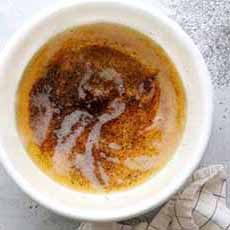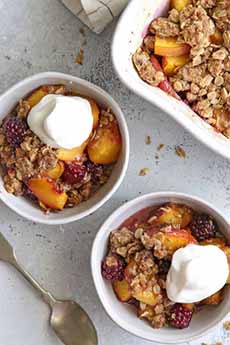TIP OF THE DAY: Brown Butter, Black Butter & How To Use Them
|
The photos that follow show the process of making brown butter.
|
Brown butter, or beurre noisette, meaning hazelnut butter in French, is a butter sauce used in French cuisine. It is used to give a dish a deeper, richer, more intense flavor than is provided by simpled melted or clarified butter. Butter is heated until it reaches a deep yellow, almost brown color, and develops a nutty scent (hence, “hazelnut butter,” even though no nuts are involved). >The history of brown butter is also below. > The different types of butter: a photo glossary. > September 22nd is National Brown Butter Day. > The year’s 5+ butter holidays are below. Black butter is actually dark brown, and brown butter is actually deep yellow, almost brown. The color and flavor chemistry behind it involves the Maillard reaction and caramelization of the milk proteins and sugars, transforming simple butter into something much more complex and aromatic. Both brown and black variations are cooked over low heat. The difference between brown butter and black butter is how long the butter is cooked. For the cook, the question is: How deep do you want the nutty/toasty flavors? Both are made by cooking unsalted butter long enough to caramelize the milk solids and turn them brown. The process also cooks out the water present in the butter, to concentrate the flavor. As the butter melts, it separates into yellow butterfat and white milk solids. The heavier milk solids sink to the bottom of the pan. As the butter cooks, the milk solids begin to brown. When they reach the color desired by the cook, the pan is removed from the heat. > There’s also beurre rouge (red butter), which substitutes red wine and vinegar for the white wine and vinegar. If butter makes everything taste better, then brown butter makes everything taste even better than that. You get more richness without added calories. Add richer flavor to: Black butter is usually flavored with tarragon vinegar or lemon juice, capers and parsley and served as a sauce with: Thanks to Go Bold With Butter for these easy steps. All you need is a unsalted butter and a skillet. Why not salted butter? Salted butter tends to foam more than unsalted butter, making it difficult to judge the color change. To watch the color change, see photo the strip of photos at the left. Preparation 1. MELT the butter over medium heat. As the butter melts, gently swirl the pan to ensure the butter doesn’t burn. 2. WATCH for the butter to splutter as the water cooks off. Stir frequently at this stage, when the butter begins to turn a light golden color. (The difference between splutter and sputter: Splutter means to spray droplets, while sputter refers to “spraying” when speaking.) 3. TURN down the heat as the sputtering subsides and the butter will turn into a light foam. 4. WATCH as the color begins to deepen into a golden color. Notice the small brown bits of milk solids developing at the bottom. You’re almost done! 5. WATCH for the butter to turn a toasted brown color (photo #4). You’ll smell the nutty aroma. Remove the pan from the heat and transfer the butter to a heat-proof bowl. 6. COOL before adding to a recipe. Store in a tightly-lidded container in the fridge. The technique of making brown butter, or beurre noisette (hazelnut butter in French, so-called for its nutty aroma and color), has a fascinating culinary history rooted in French cooking tradition. It likely emerged in French cuisine during the 18th or 19th century as chefs explored different ways to prepare and use butter. The French have long been masters of butter-based sauces, and brown butter became part of the classical French chef’s repertoire, particularly in haute cuisine. |
|
|
The process of cooking butter until the milk solids caramelize, creating a complex, nutty flavor and golden-brown color, was formalized in classical French cooking. It became one of the foundational preparations taught to culinary students. Historically, brown butter featured prominently in classic French dishes like: The technique has moved beyond French cuisine into global cooking, where cooks worldwide appreciate the depth of flavor it adds compared to regular melted butter. So many famous foods exist because of butter. A sampling: The Almond Roca brand was created in 1923 by Harry Brown and J.C. Haley of the Brown & Haley company in Tacoma, Washington. They created a buttercrunch toffee coated in milk chocolate and encrusted with chopped almonds. The name roca, meaning rock in Spanish, was inspired by its crunchy texture and the fact that almonds were often imported from Spain at the time. Almond Roca became widely popular, especially during World War II, when it was shipped to American soldiers overseas. This earned it the nickname “The Candy That Travels,” due to its long shelf life and durable packaging in airtight tins. CHECK OUT WHAT’S HAPPENING ON OUR HOME PAGE, THENIBBLE.COM. |
||







